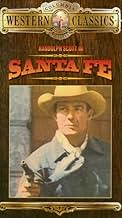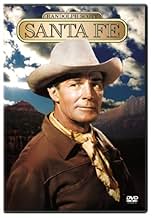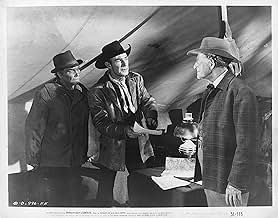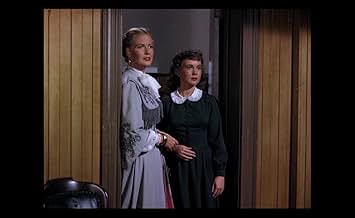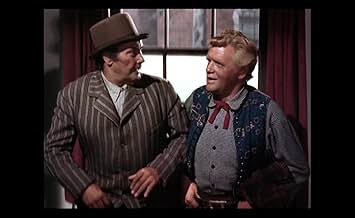IMDb RATING
6.1/10
1.2K
YOUR RATING
After their service in the Civil War, four brothers go their separate ways, but later find themselves on opposite sides of a final showdown.After their service in the Civil War, four brothers go their separate ways, but later find themselves on opposite sides of a final showdown.After their service in the Civil War, four brothers go their separate ways, but later find themselves on opposite sides of a final showdown.
- Director
- Writers
- Stars
Peter M. Thompson
- Tom Canfield
- (as Peter Thompson)
Olin Howland
- Dan Dugan
- (as Olin Howlin)
Jock Mahoney
- Crake
- (as Jock O'Mahoney)
- Director
- Writers
- All cast & crew
- Production, box office & more at IMDbPro
Featured reviews
Good but not great old time shoot-em-up western. Typical Randolph Scott pic. Brother agains brother tale. Old North/South post-war conflict. Certainly worth the 90 minutes. Good for a rainy day or lazy afternoon watch. Lots of cliches, but all good cliches. Nice cinematography. Trains. Nice sets and costumes. Black hats vs White hats. Decent acting by a lot of faces you recognize but do not know the names. Very good flat car fight on the train at the end. Of course Randolph (white hat) prevails. Last line is a classic. "As the railroad grows, so will America. You darn tootin. Please enjoy if you get the chance.
I remember that rather hilarious line from "Blazing Saddles", but I think this is the first film with Mr. Scott I've ever seen.
He was kind of the poor man's John Wayne.
The plot here is that the Civil War is over, and while his brothers carry around a lot of anger about what happened during the war, Randolf plays a guy who goes to work helping to organize and build railroads connecting the west with the rest of the country.
Some parts of the film, like the scene with the native Americans, and they remark "Some day we'll name a train after you, Chief." (Ha, ha, "Super-chief" How funny. Almost takes the sting off the genocide!) The brothers take to train robbing after gambling doesn't work out for them, and there's a bit of pathos between the good guys and bad guys and the historical Bat Matherson being dropped into the mix.
He was kind of the poor man's John Wayne.
The plot here is that the Civil War is over, and while his brothers carry around a lot of anger about what happened during the war, Randolf plays a guy who goes to work helping to organize and build railroads connecting the west with the rest of the country.
Some parts of the film, like the scene with the native Americans, and they remark "Some day we'll name a train after you, Chief." (Ha, ha, "Super-chief" How funny. Almost takes the sting off the genocide!) The brothers take to train robbing after gambling doesn't work out for them, and there's a bit of pathos between the good guys and bad guys and the historical Bat Matherson being dropped into the mix.
The time period for this film is actually pretty common for a Randolph Scott western--and about the fourth or fifth one set just after the Civil War. Like most of the films, Randolph fought for the South and now that the war is over, he has a choice to either accept the outcome or be a whiny jerk about it. Well, he's a smart guy and soon gets a job working for the Santa Fe railroad, but his three brothers who served with him aren't so bright--they hate the North so much that they do what they can to wreck things--even though there is no reasonable reason for this. So, much of the film pits Scott against his own kin (and vice-versa) as he tries hard to get the railroad completed and they work to undo it as much as possible--working for a traveling saloon whose task, it seems, is to both make money off the workers AND get them distracted from their job.
In addition to his brothers, Scott deals with a wide variety of things that might impede the progress of the railroad--rival companies, local Indian tribes and the like. This makes Scott's job in the film as a sort of trouble-shooter. How true all these problems were in the construction of the rails is beyond me and I assume that the writers took a few liberties...just a few! Overall, the film is pretty good. While it isn't among Scott's best films (they were made later in the decade and the early 60s), this is a good film from this time period.
In addition to his brothers, Scott deals with a wide variety of things that might impede the progress of the railroad--rival companies, local Indian tribes and the like. This makes Scott's job in the film as a sort of trouble-shooter. How true all these problems were in the construction of the rails is beyond me and I assume that the writers took a few liberties...just a few! Overall, the film is pretty good. While it isn't among Scott's best films (they were made later in the decade and the early 60s), this is a good film from this time period.
Enjoyed this 1951 story about the expanding of the Santa Fe Railroad through Kansas and how some Southern soldiers after the war headed North to find jobs and their leader was Randolph Scott, (Britt Canfield)
and his three brothers. There plan was to make enough money in the North and head back to Virginia, however, there was still great hatred towards the Northerners for burning their property and also claiming their homestead lands. As the Santa Fe railroad is trying to lay their track across the land there is a bunch of crooks looking for their pay checks on pay day and they set up a tent with gambling, booze and hot bar maids to grab every nickle and dime and cause great delays in the building of the railroad. Janis Carter, (Judith Chandler) is a pretty platinum blonde who captures the eye of Britt Canfield, but she hates him for killing her brother in the Civil War. Great film with steam engines burning up the tracks and even an Indian takes complete control of the engine. Enjoy a great 1951 Classis Western from the past.
and his three brothers. There plan was to make enough money in the North and head back to Virginia, however, there was still great hatred towards the Northerners for burning their property and also claiming their homestead lands. As the Santa Fe railroad is trying to lay their track across the land there is a bunch of crooks looking for their pay checks on pay day and they set up a tent with gambling, booze and hot bar maids to grab every nickle and dime and cause great delays in the building of the railroad. Janis Carter, (Judith Chandler) is a pretty platinum blonde who captures the eye of Britt Canfield, but she hates him for killing her brother in the Civil War. Great film with steam engines burning up the tracks and even an Indian takes complete control of the engine. Enjoy a great 1951 Classis Western from the past.
Randolph Scott was well into his fifties by the time of this movie, and still doing a lot of his own action scenes and stunts.
Many movie stars of those days stayed fit by lifting weights and swimming - guys like Cary Grant and Fred Astaire - both lifelong friends of Randolph Scott - had weight rooms in their homes and also at their home studio (Astaire who was a flyweight of around 145 lbs., worked out with 5lb bells and would do hundreds of reps while rehearsing dance steps!). John Wayne was a serious weight lifter who would rack up some amazing reps with the curling bars, and Charles Bronson had some ingenious gadgets for isometric exercises. Robert Taylor was a track star in college, and would run for miles at a stretch on his ranch.
Other actors, though, like Joel McCrea, Gary Cooper, Clark Gable, and our "Santa Fe" star, Randolph Scott, stayed fit simply by working their ranches.
In this movie, Scott looks like a rawhide whip, his movements lithe and graceful and the moving camera shots (taken from a pickup) of him galloping on horseback show a stunning physique. An old friend of this reviewer's family used to tell a story of Randolph Scott pulling an old 1940s Ford pickup around with a rope. For those of us who have worked around vehicles from that era, that really is an amazing feat of strength.
Scott is surrounded by... maybe less than stellar performers for "Santa Fe," and this doesn't feel like one of his greatest performances. But it's got plenty of action and drama for a Saturday afternoon movie.
Many movie stars of those days stayed fit by lifting weights and swimming - guys like Cary Grant and Fred Astaire - both lifelong friends of Randolph Scott - had weight rooms in their homes and also at their home studio (Astaire who was a flyweight of around 145 lbs., worked out with 5lb bells and would do hundreds of reps while rehearsing dance steps!). John Wayne was a serious weight lifter who would rack up some amazing reps with the curling bars, and Charles Bronson had some ingenious gadgets for isometric exercises. Robert Taylor was a track star in college, and would run for miles at a stretch on his ranch.
Other actors, though, like Joel McCrea, Gary Cooper, Clark Gable, and our "Santa Fe" star, Randolph Scott, stayed fit simply by working their ranches.
In this movie, Scott looks like a rawhide whip, his movements lithe and graceful and the moving camera shots (taken from a pickup) of him galloping on horseback show a stunning physique. An old friend of this reviewer's family used to tell a story of Randolph Scott pulling an old 1940s Ford pickup around with a rope. For those of us who have worked around vehicles from that era, that really is an amazing feat of strength.
Scott is surrounded by... maybe less than stellar performers for "Santa Fe," and this doesn't feel like one of his greatest performances. But it's got plenty of action and drama for a Saturday afternoon movie.
Did you know
- TriviaAfter the Indian chief ran the train, Scott told the chief someday they will name a train after him. They did: the Santa Fe Super Chief.
- GoofsThe narration says Lincoln said "with malice toward none, with charity towards all" at Gettysburg. The quote is from his second inaugural address delivered at the capitol.
- How long is Santa Fe?Powered by Alexa
Details
- Runtime1 hour 27 minutes
- Aspect ratio
- 1.33 : 1
Contribute to this page
Suggest an edit or add missing content


